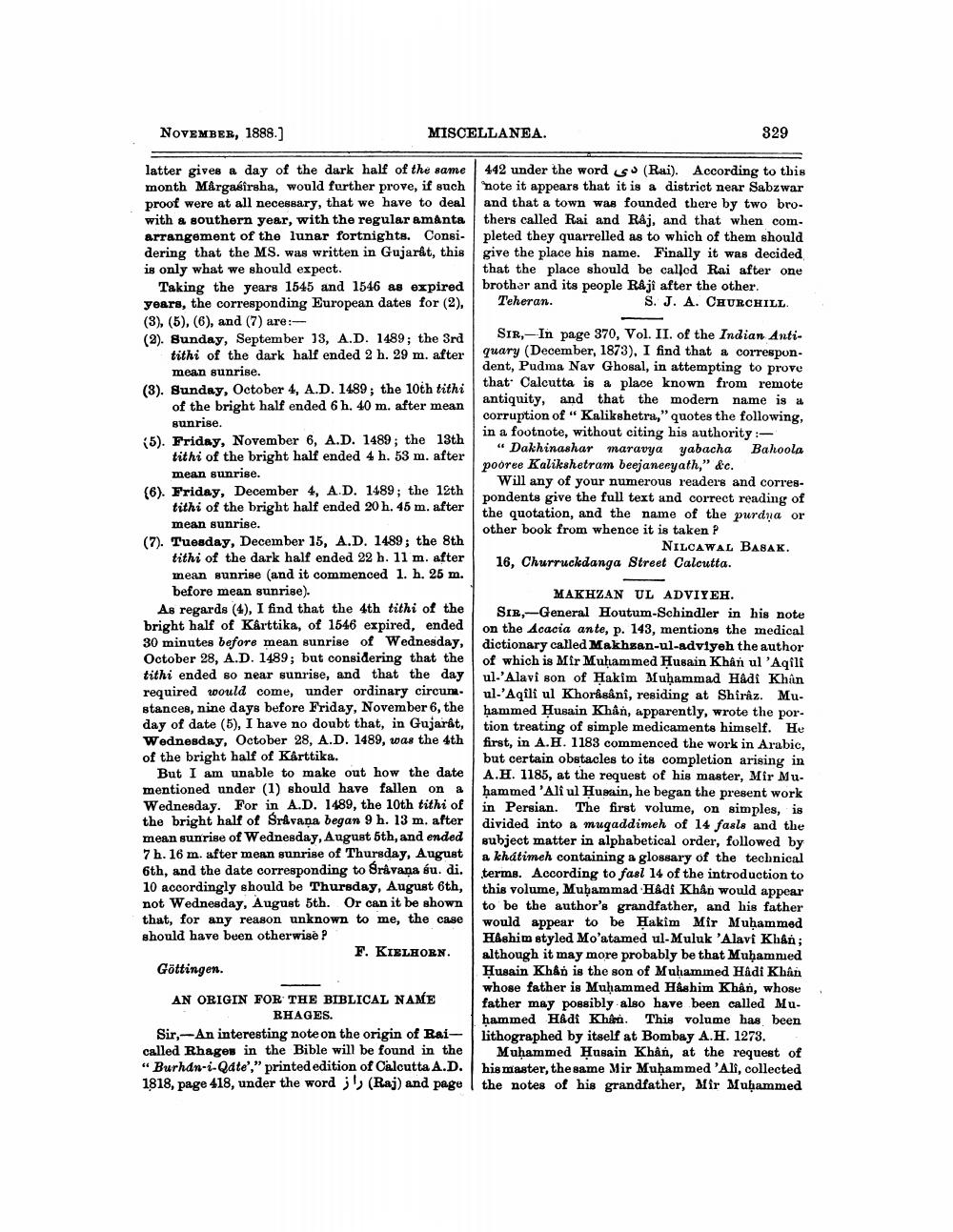________________
NOVEMBER, 1888.)
MISCELLANEA.
329
442 under the words (Rai). According to this note it appears that it is a district near Sabzwar and that a town was founded there by two bro. thers called Rai and Raj, and that when com. pleted they quarrelled as to which of them should give the place his name. Finally it was decided that the place should be called Rai after one brother and its people Raji after the other. Teheran.
S. J. A. CHURCHILL
SIR,- In page 370, Vol. II. of the Indian Antiquary (December, 1873). I find that a correspo dent, Pudma Nav Ghosal, in attempting to prove that: Calcutta is a place known from remote antiquity, and that the modern name is a corruption of "Kalikshetra," quotes the following, in a footnote, without citing his authority :
« Dakhinashar maravya yabacha Bahoola pooree Kalikshetram beejaneeyath," &c.
Will any of your numerous readers and correspondents give the full text and correct reading of the quotation, and the name of the purdya or other book from whence it is taken P
NILCAWAL BABAK. 16, Churruckdanga Street Calcutta.
latter gives a day of the dark half of the same month Margadirsha, would further prove, if such proof were at all necessary, that we have to deal with a southern year, with the regular amanta arrangement of the lunar fortnights. Consi- dering that the MS. was written in Gujarft, this is only what we should expect.
Taking the years 1545 and 1546 as expired years, the corresponding European dates for (2), (3), (5), (6), and (7) are:(2). Bunday, September 13, A.D. 1489; the 3rd
tithi of the dark half ended 2 h. 29 m. after
mean sunrise. (8). Sunday, October 4, A.D. 1489; the 10th tithi
of the bright half ended 6 h. 40 m. after mean
sunrise. (5). Friday, November 6, A.D. 1489; the 13th
tithi of the bright half ended 4 h. 53 m. after
mean sunrise. (6). Friday, December 4, A.D. 1489; the 13th
tithi of the bright half ended 20 h. 45 m. after
mean sunrise. (7). Tuesday, December 15, A.D. 1489; the 8th
tithi of the dark half ended 22 h. 11 m. after mean sunrise (and it commenced 1. h. 26 m.
before mean sunrise). As regards (4), I find that the 4th tithi of the bright half of Kárttika, of 1546 expired, ended 30 minutes before mean sunrise of Wednesday, October 28, A.D. 1489; but considering that the tithi ended so near sunrise, and that the day required would come, under ordinary circum- stances, nine days before Friday, November 6, the day of date (5), I have no doubt that, in Gujarat, Wednesday, October 28, A.D. 1489, was the 4th of the bright half of Karttika.
But I am unable to make out how the date mentioned under (1) should have fallen on a Wednesday. For in A.D. 1489, the 10th tithi of the bright hall of Sravana began 9 h. 13 m. after mean sunrise of Wednesday, August 5th, and ended 7 h. 16 m. after mean sunrise of Thursday, August 6th, and the date corresponding to Sravana su. di. 10 accordingly should be Thursday, August 6th, not Wednesday, August 5th. Or can it be shown that, for any reason unknown to me, the case should have been otherwise ?
F. KIELHORN Göttingen.
MAKHZAN UL ADVIYEH. SIR-General Houtum-Schindler in his note on the Acacia ante, p. 143, mentiong the medical dictionary called Makhzan-ul-adviyoh the author of which is Mir Muhammed Husain Khań ul 'Aqilt ul-'Alavi son of Hakim Muhammad Hadi Khan ul-'Aqili ul Khorasani, residing at Shiraz. Muhammed Husain Khân, apparently, wrote the por. tion treating of simple medicamente himself. He first, in A.H. 1183 commenced the work in Arabic, but certain obstacles to its completion arising in A.H. 1185, at the request of his master, Mir Muhammed 'Aliul Husain, he began the present work in Persian. The first volume, on simples, is divided into a muqaddimeh of 14 fasls and the subject matter in alphabetical order, followed by a khátimeh containing a glossary of the technical terms. According to fasl 14 of the introduction to this volume, Mubammad Hadi Khan would appear to be the author's grandfather, and his father would appear to be Hakim Mir Muhammed HÅshim styled Mo'atamed ul-Muluk 'Alavi Khan; although it may more probably be that Muhammed Husain Khan is the son of Muhammed Hadi Khan whose father is Muhammed Hashim Khan, whose father may possibly also have been called Mu. hammed Hadi Khan. This volume has been lithographed by itself at Bombay A.H. 1273.
Muhammed Husain Khan, at the request of his master, the same Mir Muhammed 'Ali, collected the notes of his grandfather, Mir Muhammed
AN ORIGIN FOR THE BIBLICAL NAME
RHAGES. Sir-An interesting note on the origin of Rai- called Rhages in the Bible will be found in the "Burhan-e-Qate'," printed edition of Calcutta A.D. 1818, page 418, under the word ; ' (Raj) and page




